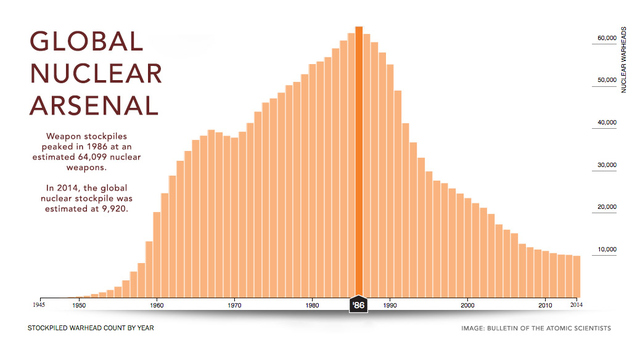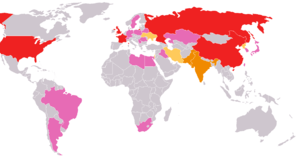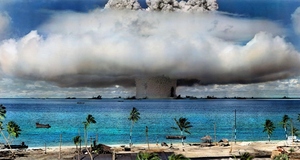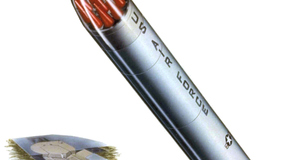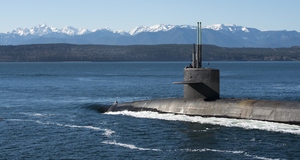Theories of Nuclear Proliferation: Why Do States Seek Nuclear Weapons?
By
2016, Vol. 8 No. 08 | pg. 1/1
IN THIS ARTICLE
Nuclear weapons are the most powerful and destructive weapons held in the aresenals of any modern states. Since the creation of the nuclear bomb, many have feared that a nuclear war could lead to the end of life on earth as we currently know it. The Treaty on the Non-Proliferation of Nuclear Weapons (NPT) is the central organisation working towards maintaining nuclear peace and preventing the further spread of nuclear arms (Graham 2004, 285). The NPT’s main focus is preventing further nuclear proliferation (Ford 2007, 403). The reasons why states have sought nuclear weapons since the Second World War (WW2) are explored below. In particular, this analysis focuses on state survival, national prestige, and ‘great power’ status theories, which are the most prominent theories used in explaining nuclear proliferation. Additionally, the issues related to non-proliferation and reductions to current nuclear weapon stockpiles are discussed. State Survival TheoryNuclear proliferation refers to the spread of nuclear weapons and the technology used to produce such weapons, and to the process by which a state develops and/or comes into possession of nuclear weapons (US Department of Defence 2005). The first nuclear fight for survival ended in 1945 when the United States (US) used two nuclear bombs against Japan to bomb the cities of Hiroshima and Nagasaki (Carroll 2007). However, after WW2 the Union of Soviet Socialist Republics (USSR) accelerated its nuclear development program, due to fears that the US and their Allies would attack them (Holloway 1995, 271-273). This highlights states working towards gaining nuclear arms in the interest of their survival, and this initiated the Cold War. The concept of ‘survival’ within an anarchic world is a strong argument in understanding a state’s desire to seek nuclear arms. Realists generally believe that states must fight for their own survival; this is due to their theory that the world is in a state of anarchy (Mearsheimer 2006, 71-88). During WW2, the US, United Kingdom (UK), Germany, Japan and the USSR all had nuclear weapon programs at various stages of development (Burr and Richelson 2001, 62). The side to ‘develop a nuclear bomb first would have the ability to win the war, and survive’ (Holloway 1981, p. 163). Carranza (2006, 502) argues that using nuclear weapons to defend a state can be a positive action, as other states are less likely to be aggressive towards a nuclear-armed state. This highlights the benefits of proliferation, and supports the survival theory. Another reason for less potential aggression from other states is due to the fear that just one single nuclear exchange between two states could lead to devastating effects (Starr 2011). However, a downside to one state having nuclear weapons is that other states may feel threatened by this and actively seek nuclear weapons themselves (Sidel et al. 2007, 1591). The Cold War saw an acceleration of states that sought to gain nuclear weapons in the interest of their survival (Holloway 2010, 379). In particular, for the UK and France, this was due to their doubts that the US’s guarantee of nuclear protection to North Atlantic Treaty Organisation (NATO) member states could be relied upon (Pifer 2011, 13-16). A secondary argument relates to ‘great power’ status as the reason for both the UK and France seeking nuclear weapons (Gowing 1974); this will be discussed further later. Because of doubts relating to NATO, the UK and France moved forward with their own nuclear weapons programs to have better control over their own survival (Hill et al. 1995, 19). The necessity for the UK’s nuclear weapons program has been questioned on numerous occasions. For example, Hill et al. (1995, 19) argue that the UK’s nuclear weapons had absolutely no influence at all during the Cold War, and did not deter any potential enemies. This highlights that a state’s survival by means of nuclear weapons is not always necessary, but this does not necessarily remove the desire for proliferation. This could at times be seen as the state survival theory being used as an excuse or a fear campaign to gain public support for nuclear development (Doyle 2013, 10). In Eastern and Southern Asia, China started a nuclear arms survival race, involving India and Pakistan. In the face of the Korean War and the Taiwan Straits Crisis, China started developing nuclear weapons in 1954 (Burr and Richelson 2001, 69). This was seen as a deterrent for the US and later the USSR (Stephan 1996). Roberts et al. (2000) argue that China is often forgotten in the nuclear weapons world, and that China’s nuclear program ultimately led to India and then, in turn, Pakistan developing their own nuclear arsenals. The survival theory in this case is supported by China’s No First Use Policy, whereby they have pledged to only use their nuclear arsenal in retaliation to nuclear attack from another state (Nuclear Files 1995). However, China’s credibility as to whether they would honour their No First Use Policy has been questioned, placing their defensive/survival intentions in question (Ullman 1972, 66). After China’s first nuclear tests in 1964, India started pushing forward with nuclear development, with their program starting in 1967, and first test in 1974 (Perkovich 1999, 15). There are many arguments for why India wanted nuclear weapons, mainly focused on the concept of state survival. For example, Riedel (2012) believes that the 1962 Himalayan border war between India and China was the most influential factor in India’s decision to develop a nuclear arsenal. This can be seen to emphasise India’s desire for nuclear weapons as a decision based on the state’s survival. Furthermore, in 1972 Pakistan (Perkovich 1999, 19) started working towards obtaining a nuclear capability due to India’s nuclear program and, in particular, the 1971 Indo-Pakistani War that cost Pakistan a lot of territory. These tensions led Pakistan to nuclear development in fear of their state’s survival in case of further war with India (Haqqani 2005, 91). It could be argued that China, India and Pakistan all had very reasonable grounds to seek nuclear weapons, due to past wars and ongoing security concerns. National Prestige Theory and North KoreaIt has been argued that many authoritarian regimes seek nuclear weapons for national prestige, often thought to be a way of becoming an international player (O’Neill 2006, 1). For example, North Korea’s recent nuclear weapons proliferation and tests are believed by some to be for national prestige, both internationally and domestically (O’Neill 2006, 4). Kim argues that the domestic factor in North Korea’s case is a way for Kim Jong-Il and, since his death, Kim Jong-un to show the military and citizens their strength (2014, 218-219). Ji (2009, 8) states that ‘the interests of the military and Kim Jong-Il are inevitably concentrated on the nuclear weapons program to assure the survival of his regime’. ‘Survival of his regime’ can be seen to extend to gaining national prestige from proliferation through continued power. However, many disagree with the national prestige theory in the case of North Korea’s motivation for nuclear weapons. For example, Faulkner (2010) argues that North Korea’s nuclear program is centred on their Military First Policy and rewarding loyal military leaders with the funding and resources necessary to produce nuclear weapons. This could imply that Kim Jong-Il/ Kim Jong-un sought nuclear weapons as a means to maintain power, by keeping military leaders happy. For North Korea, it can be argued that national prestige maybe an internal prestige, one based on keeping the regime in power. Many also see North Korea’s nuclear program as at least partly due to state survival. This argument is in line with North Korea’s official reasoning behind its nuclear program (Kerr, Hildreth, and Nikitin 2016, 20-21). The US and South Korea have been cited by the North Korean government as the biggest threats to their survival (Kerr, Hildreth, and Nikitin 2016, 20-21). Gebru (2015, 350) believes that no one theory explains North Korea’s intentions; rather a mixture of reasons are most likely behind their ongoing nuclear program. This includes national prestige theory, which could be being used to support the North Korean government’s public projection of their state’s world power status to the North Korean people. ‘Great Power’ StatusGowing (1974) has argued that both the UK and France entered their respective nuclear programs because of ‘great power’ status theory. Gowing (1974) describes ‘great power’ status as the phenomenon of past powerful states looking to regain/retain at least a minimal amount of their past or current power. The two world wars saw the end of both France and the UK’s former ‘great power’ status, and each are argued to have seen nuclear weapons as a needed factor of current and future ‘great powers.’ Pifer (2011, 4-6) believes that there were genuine fears about NATO’s reliability, but the desire to retain some power was also a factor in seeking nuclear arms. Another factor was that the US was seen as having too much control over NATO which, considering both states’ previous levels of military power, left them feeling powerless (Chalmers and Walker 2002, 4). As mentioned previously, there has been much debate in the UK about the necessity for and the effectiveness of its nuclear weapons. Debates have arisen in the UK regularly, especially whenever renewal and reinvestment is necessary for the UK’s Trident nuclear weapons system. Gowing (1974) has repeatedly argued that if the UK ended Trident it would lose its most powerful military asset. Moreover, Chalmers and Walker (2002, 5) have stated that the loss of Trident would mean that the UK would lose status which, it can be argued, is the fear of loss of ‘great power’ status. French nuclear weapons are often cited by the French Government as being central to the state’s autonomy (Yost 1996). The French have in recent times had less public call for disarmament than the UK. However, France did face tough internal and external criticism during their 1990s nuclear testing in the South Pacific (Siskin 2014, 190). In recent times, France has also been pressured about trusting NATO, like all other European Union states (Siskin 2014, 199-200). However, there is no indication that France would consider disarming its nuclear weapons (Siskin 2014, 203). Nuclear Non-Proliferation IssuesPast attempts towards achieving nuclear non-proliferation and disarmament of nuclear weapons have had some success, although this has been limited. Nuclear disarmament has occurred in South Africa, Kazakhstan, the Ukraine and Belarus, with each state giving up nuclear weapon possession (Global Security n.d.). South Africa’s motivation for holding nuclear weapons was the threat from Soviet and Soviet-backed states. When this threat abated, such as when the Cuban military in Angola was no longer a threat in the late 1980s and early 1990s, they disarmed (Pabian 1995). This highlights South Africa’s desire to seek nuclear weapons as due to the need for survival, with disarmament occurring once the threat to their survival ceased to exist. In the case of Kazakhstan, the Ukraine, and Belarus, all three inherited nuclear weapons upon separation from the USSR (Woolf 1996). Kiernan (2008) believes that the main reason for these three states giving up nuclear weapons was the economic incentives offered by the West and a desire for acceptance from the world in the post-Cold War era. In addition, Brazil and Argentina agreed to end their nuclear programs after years of each state being suspicious of the other’s program (Kiernan 2008, 19-20). Although neither state ever produced nuclear weapons, this is thought to be a good non-proliferation outcome, through the peaceful end of a nuclear arms race. The number of nuclear weapons in existence has been dramatically reduced, peaking at approximately 65,000 in 1985-86 (Webster 2012) and reduced to approximately 10,000 in 2014 ("Nuclear Notebook" 2016). This could be seen to be a positive move towards disarmament, compared to the Cold War years. Although nuclear non-proliferation and disarmament have been successful to a certain degree, no other nuclear powers that developed their own nuclear weapons have completely disarmed, other than South Africa (Sidel and Levy 2007, 1592). Hence, although there has been success in disarmament, it is argued that complete disarmament and non-proliferation is highly unlikely. The prospect for non-proliferation and, furthermore, the total removal of all nuclear weapons by all nuclear weapon states, is argued by many to be an impossible task (Snider 1995, 95-96). One reason for this is that nuclear-armed states, such as the US and Russia, are signed up to the NPT, yet they still possess nuclear weapons (UNODA n.d.). Butcher (2010) believes that until these nations make larger reductions in their nuclear arsenals, attempts at countering states looking towards proliferation may be difficult. This is because no other state seeking nuclear arms would take seriously another state with nuclear weapons requesting that they discontinue their program. The US and Russia signed the ‘New Start’ treaty in 2010 to work towards having only 1500 active nuclear weapons between them, although new nuclear development continues (Shear 2010). A key example of this was the US’s 2012 defence budget, which allowed funding for modernisation of their nuclear weapons arsenal (Kristensen 2012). This can be seen to highlight the gradual reductions that are being made, but also the degree of difficulty faced in gaining total disarmament and non-proliferation. Thus, reductions of nuclear arsenal can be seen as positive, but current nuclear modernisation, as seen in the US, could overshadow hopes of total nuclear disarmament and hamper efforts to stop further states seeking nuclear weapons. ConclusionState survival is arguably the principal reason that states have sought nuclear arms. The proliferation of nuclear weapons has in turn led other states to seek nuclear weapons for their own state’s survival. The main period in history that this nuclear arms race occurred was during the Cold War. Although, analysing national prestige theory also raised that North Korea may have at least in part used this theory in its desire for nuclear weapons. However, this does not completely extinguish the state survival theory and proliferation as a means for ongoing authoritarian rule in North Korea. ‘Great power’ status for the UK and France was also highlighted as a likely factor in each state seeking nuclear arms. This continues, especially in the UK, which has had high levels of criticism of its continued nuclear weapons. Finally, while some progress has been made in both preventing further states from seeking nuclear arms, and reductions in nuclear stockpiles, it has also had limitations. Nuclear states, especially the US and Russia, can be seen as central in leading the way by example if stopping proliferation is to be achieved. However, to lead by example, these states would need to actively move towards completely removing their nuclear weapons capabilities, which is not at all likely, at least not in the near term. ReferencesAnthony, I. 2009. “NATO and nuclear weapons.” Politique Etrangere 16 (5): 159-171, viewed 6 September 2015, http://www.cairn.info/revue-politique-etrangere-2009-5-page-159.htm. Burr, W and J. Richelson. 2001. “Whether to ‘strangle the baby in the cradle’: the United States and the Chinese nuclear program, 1960-1964.” International Security 25 (3): 54-99. Butcher, S. 2010. “Reduce nuclear arms, set an example.” The Guardian, March 22, viewed 8 September 2015, http://www.guardian.co.uk/commentisfree/2010/mar/22/nuclear-weapons-reduce-obama-uk. Carroll, J. 2007. House of war: the pentagon and the disastrous rise of American power. Boston: Houghton Mifflin Harcourt. Carranza, M. 2006. “Can the NPT Survive? The Theory and Practice of US Nuclear Non-proliferation Policy after September 11.” Contemporary Security Policy 27 (3): 489-525. Chalmers, M and W Walker. 2002. “The United Kingdom, nuclear weapons, and the Scottish question.” The Nonproliferation Review 8 (2): 1-15. Doyle, J. 2013. “Why eliminate nuclear weapon?.” Survival: global politics and strategy 55 (1): 7-34. Faulkner, G. 2010. “Method to the madness- why North Korea wants the bomb.” Paper presented at the Australian Political Science Association Conference, Melbourne University, 27-29 September 2010. Ford, C. 2007. “Debating disarmament: interpreting article VI of the Treaty on the Non-Proliferation of Nuclear Weapons.” Nonproliferation Review 14 (3): 389-409. Gebru, A. 2015. “North Korea’s nuclear program and the Treaty on the Non-Proliferation of Nuclear Weapons: the controversy and its implications.” African Journal of Political Science and International Relations 9 (9): 349-360, viewed 19 September 2015, www.academicjournals.org/journal/AJPSIR/article/D8C53A254835. Global Security No Date. “Ukraine special weapons.” Weapons of mass destruction (WMD), viewed 12 September 2015, http://www.globalsecurity.org/wmd/world/ukraine/index.html. Gowing, M. 1974. Independence and deterrence: Britain and atomic energy, 1945-1951. London: Macmillan. Graham, T. 2004. “Avoiding the tipping point.” In The nuclear tipping point: why states reconsider their nuclear choices, edited by K. Campbell, R. Einhorn and M. Reiss, Washington: Brookings Institution Press. Haqqani, H. 2005. Pakistan: between mosque and military. Washington: Brookings Institution Press. Hill, C, R Pease, R Peierls, and J Rotblat. 1995. Does Britain need nuclear weapons? London: British Pugwash Group. Holloway, D. 1981. “Entering the nuclear arms race: the Soviet decision to build the nuclear bomb, 1939-45.” Social Studies of Science 11 (2): 159-197, viewed 2 September 2015, http://www.jstor.org/discover/10.2307/284865?uid=3737536&uid=2129&uid=2&uid=70&uid=4&sid=21100923721291. Holloway, D. 1995. Stalin and the bomb: the Soviet Union and atomic energy 1939-1956, New Haven: Yale University Press. Holloway, D. 2010. “Nuclear weapons and the escalation of the Cold War, 1945-1962.” In The Cambridge History of the Cold War: 379-397. Ji, J. 2009. “Three paradigms of North Korea’s nuclear ambitions.” Journal of Political Inquiry viewed 11 September 2015, http://jpi-nyu.org/wp-content/uploads/2011/02/JPI-2-JI.pdf. Kerr, P, S Hildreth, and M Nikitin. 2016. “Iran-North Korea-Syria ballistic missile and nuclear cooperation.” Congressional Research Service viewed 27 July 2016, http://www.fas.org/sgp/crs/nuke/R43480.pdf. Kiernan, K. 2008. “Why do states give up nuclear arsenals: proliferation as economic bargaining.” Bologna Center Journal of International Affairs 11 (2): 17-31. Kim, J. 2014. The North Korean nuclear weapons crisis: the nuclear taboo revisited? London: Palgrave MacMillian. Kristensen, H. 2012. “The nuclear weapons modernization budget.” Federation of American Scientists viewed 21 September 2015, http://www.fas.org/blog/ssp/2011/02/nuclearbudget.php. Mearsheimer, J. 2006. “Structural realism.” In International relations theories: discipline and diversity, edited by T Dunne, M Kurki and S Smith, Oxford: Oxford University Press. Nuclear Files. 1995. No first use policy of the declared nuclear states, April 5 and 6, viewed 13 September 2015, http://www.nuclearfiles.org/menu/key-issues/nuclear-weapons/issues/policies/no-first-use_1995-04-05.htm. "Nuclear Notebook: Nuclear Arsenals of the World." 2016. Bulletin of the Atomic Scientist. Accessed August 2016, http://thebulletin.org/nuclear-notebook-multimedia. O’Neill, B. 2006. “Nuclear weapons and national prestige.” Cowles Foundation, Discussion Paper No. 1560, viewed 11 September 2015, http://cowles.econ.yale.edu/P/cd/d15b/d1560.pdf. Pabian, F. 1995. “South Africa’s nuclear weapon program: lessons for U.S. non-proliferation policy.” The Non-proliferation Review 2 (1). Perkovich, G. 1999. India’s nuclear bomb: the impact on global proliferation. Berkeley: University of California Press. Pifer, S. 2011. “NATO, nuclear weapons and arms control.” Brookings Institute Arms Control Series, Paper 7, viewed 3 September 2015, http://www.brookings.edu/wp-content/uploads/2016/06/0719_arms_control_pifer.pdf. Riedel, B. 2012. “JFK’s overshadowed crisis.” The National Interest July-August. Roberts, B, R Manning, and R Montaperto. 2000. “China: the forgotten nuclear power.” Foreign Affairs 79 (4): 53-63, viewed 8 September 2015. http://www.jstor.org/stable/20049808. Shear, M. 2010. “Obama, Medvedev sign treaty to reduce nuclear weapons.” The Washington Post April 8, viewed 11 September 2015, http://www.washingtonpost.com/wp dyn/content/article/2010/04/08/AR2010040801677.html. Sidel, V and B Levy. 2007. “Proliferation of nuclear weapons: opportunities for control and abolition.” American journal of Public Health 97 (9): 1589-1594. Siskin, K. 2014. “Does international law reflect international opinion? French nuclear testing in the twentieth century.” Journal of International Law and Company Law 26 (2): 187-214. Snider. J. 1997. “Intellectual honesty, nuclear weapons and disarmament.” Center for Strategic and International Studies viewed 21 September 2015, http://csis.org/images/stories/poni/110921_Snider.pdf. Stephan, J. 1996. The Russian Far East: a history, Stanford: Stanford University Press. Starr, S. 2011. “U.S. and Russian launch-ready nuclear weapons: a threat to all nations and peoples.” Physicians for Social Responsibility viewed 18 September 2015, www.wagingpeace.org/articles/pdfs/2011_06_24_starr.pdf. UNODA. no date. “Treaty on the non-proliferation of nuclear weapons.” viewed 11 September 2015, http://disarmament.un.org/treaties/t/npt?OpenView. Ullman, R. 1972. “No first use of nuclear weapons.” Foreign Affairs 50 (4): 61-78. Webster, P. 2012. “Nuclear weapons: how many are there in 2012.” The Guardian Online viewed 11 September 2015, http://www.guardian.co.uk/news/datablog/2012/sep/06/nuclear-weapons-world-us-north-korea-russia-iran. Woolf, A. 1996. “91144: nuclear weapons in the former Soviet Union: location, command, and control.” Congressional Research Service. Yost, D. 1996. “France’s nuclear dilemmas.” Foreign Affairs 14 (1) viewed 2 September 2015, http://www.foreignaffairs.com/article/1996-01-01/francesnucleardilemmas. Suggested Reading from Inquiries Journal
Inquiries Journal provides undergraduate and graduate students around the world a platform for the wide dissemination of academic work over a range of core disciplines. Representing the work of students from hundreds of institutions around the globe, Inquiries Journal's large database of academic articles is completely free. Learn more | Blog | Submit Latest in Political Science |

